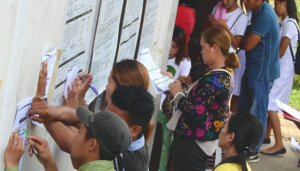 DAVAO CITY (MindaNews) – The Davao region recorded 4,977 COVID-19 cases in the first 13 days of June, surpassing its record of 4,658 in the entire 31 days of May, with over 500 new cases daily on June 10, 11 and 12.
DAVAO CITY (MindaNews) – The Davao region recorded 4,977 COVID-19 cases in the first 13 days of June, surpassing its record of 4,658 in the entire 31 days of May, with over 500 new cases daily on June 10, 11 and 12.
In Davao City, which accounts for 2,496 cases or 50.15% of 4,977, the state-run Southern Philippines Medical Center (SPMC) reported a 100% occupancy of its 321 COVID ward beds and 95.40% or 83 out of 87 COVID ICU beds as of 12 noon Sunday while private hospitals have been displaying notices outside or at the entrance that they could no longer accommodate COVID-19 patients because their beds are fully occupied.
Davao City also surpassed its May 2021 record of 2,490 cases with 2,496 cases reported in the first 13 days of June.
In May, the region comprising the five Davao provinces – de Oro, del Norte, del Sur, Occidental and Oriental – and the cities of Davao, Panabo, Island Garden City of Samal, Tagum, Digos and Mati, recorded a total of 4,658 new cases – from 28,056 on May 1 to 23,398 on May 31, based on the daily reports of the regional Department of Health- Center for Health Development.
Of the 4,977 cases logged in the first 13 days of June, 1,564 were recorded on June 10, 11 and 12 , with 510 on June 10; 526 on June 11; and 528 on June 12. On June 13, the DOH-Davao report listed 403 as new cases but between 33,085 total number of cases on June 12 and 33,481 on June 13 is 396 cases.
Davao City recorded the highest increase in 13 days: 2,496 out of the 4,977 regional cases – from 17,337 on June 1 to 19,833 on June 13. The city recorded its highest single day increase since its first case of COVID-19 in mid-March 2020, at 337 on June 1 while the region did so on June 12 at 528.
Before June 2021, the region’s highest single day increase was 241, recorded on November 10, 2020. On the same day, Davao City recorded its highest at 195, replicated only on May 29. Two days later, on June 1, the city broke this record with 337 new cases.
As of June 13, the Davao region reported a total of 33,481 cases, out of which 6,409 are active, 25,849 are recoveries and 1,223 are deaths. As of June 13, Davao City recorded a total number of 19,833 cases, out of which 3,353 are active, 15,677 are recoveries and 803 are deaths.
After Davao City, the province of Davao del Norte posted the highest increase in 13 days, with 999 (5,299 on June 1 and 6,298 on June 13); Davao de Oro with 530 (1,985 on June 1 to 2,515 on June 13); Davao del Sur with 486 (1,874 on June 1 to 2,360 on June 13); Davao Oriental with 380 (1,690 on June 1 to 2,070 on June 13) and Davao Occidental with 86 (319 on June 1 to 405 on June 13).
In May, 2,490 cases were recorded in Davao City, 1,150 in Davao del Norte, 415 in Davao de Oro, 280 in Davao del Sur, 251 in Davao Oriental and 72 in Davao Occidental.
Fully occupied
The state-run hospital being fully occupied, some private hospitals reopened their COVID-19 beds as the number of cases surged in the last week of May.
MindaNews checked the private hospitals with COVID ward beds on Saturday and found notices informing the public they could no longer accommodate patients as they are fully occupied. These notices had been posted there for several days.
A huge tarpaulin can be seen on the corner of the road leading to the Brokenshire Hospital and outside its emergency room: “We are sorry to inform the public that our COVID beds are full,” the tarpaulins read.
At the Davao Doctors’ Hospital, a signage says “We Are Full” and “patients suspected of COVID-19 can NO LONGER BE ACCOMMODATED in our holding areas.”
At the entrance of San Pedro Hospital, one is greeted with a public advisory that “Our COVID-19 and Isolation Units are now full & could no longer accommodate new COVID-19 patients.”
Patients not requiring hospitalization are supposed to be isolated in temporary treatment and monitoring facilities (TTMFs) but complaints have been aired about delays in the transport of patients. A COVID-positive patient, for example, waited for five days before he could be moved to a TTMF.
Ideally, a COVID-positive is supposed to be transported to the isolation or treatment facility within 24 hours.
In some cases, because waiting for transport took days, what would have been the lone COVID-19 patient in the household ended up infecting the rest of the family.
Awaiting transport
Asked what was causing the delay in transporting the patients and how many ambulances were the city deploying 24/7 to fetch the COVID-positives, Dr. Michelle Schlosser, the city’s COVID-19 Task Force spokesperson, told MindaNews on June 8 that the city has a RAT (Rapid Action Team) “to do the extraction of patients from their respective homes to be admitted either at the TTMFs or hospitals depending on their health status (asymptomatic, mild, moderate, severe or critical).”
She cited three problems on extraction: resistance of the patients to be admitted, declaration of wrong address and turning off of phones.
Schlosser said “it takes days to convince them to voluntarily submit themselves to be admitted.”
She said they sometimes seek police assistance to extract the patients “as significant number of our patients were quite aggressive towards our ground contact tracers and RAT responders.”
Schlosser also noted that some patients give wrong addresses. “Since our contact tracing is done through phone, our ground contact tracers are reliant (on) what their patient declares. Unfortunately, we still have patients (who) are uncooperative and would rather put his/her loved ones as well as the community at risk just to evade being extracted and admitted to our TTMFs/hospital.”
She also said there are patients “who turn off their phone at the time of extraction “which makes our RAT team clueless as to their location especially if the address given is incomplete or not correct.”
The patients monitored by MindaNews who were awaiting transport did not resist admission, did not give wrong addresses and did not turn off their phones but anxiously waited for days to be transported to the TTMFs.
Schlosser said they are “facing a huge number of patients to be transported to TTMFs and hospital 24/7. Our teams are working hard round the clock.”
Schlosser did not respond to the query on how many ambulances the city was deploying for transport of COVID-19 positives.
“For severe to critical COVID patients who are ICU (Intensive Care Unit) requiring — our hospitals are full,” she said on June 8.
“What are the other possible alternatives to give those requiring ICU a chance to live?” MindaNews asked Schlosser. She sent no reply.
On June 8, the city’s total number of cases was 18,653 (2,683 active, 15,186 recoveries and 784 deaths). By June 13, the city posted 19,833 cases or 1,180 more. Of 19,833, the city recorded 3,353 active, 15,677 recoveries and 803 deaths). (Carolyn O. Arguillas / MindaNews)





